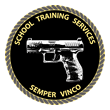Introduction of Instructors and training outline (expectations of students)
Weapons safety brief 1 Hrs
- 4 Rules of gun safety
Guns and Gear 2 Hrs
- Weapons nomenclature
- Cleaning and maintenance
- Weapon Storage
- Pistol nomenclature
- Storage and methods of carry
- Choosing the correct gear
Pre-Shooting Training 6 Hrs
- Dry fire exercises
- Holster drills
- Movement drills
- Reloads
- Clearing stoppages
- Range procedures and range safety
Live Fire Training 16 Hrs
- Fundamentals of firearms
- Practice and evaluation
- Drawing the pistol
- Clearing Malfunctions
- Speed and Accuracy drills
- Tactical and emergency reloading
- Moving and Shooting
- Pistol qualification (CLEST Model course of fire)
- Shoot/Don't shoot drills
- Hostage drill
Legal 1 Hrs
- Legal authority of CSSOs
- Classification of crimes
- Arrests and detentions
The law and use of force 4 Hrs
- Non-deadly force / Deadly force
- Civil penalties /Criminal penalties
- Case studies and discussion
- Common crimes encountered
- Appropriate actions for CSSOs
- Company/site/account specific legal issues
- Relevant statutes and case law
- Discussion about fleeing individuals
- Discussion of the criminal ramifications of firing a warning shot
Field note taking 1 Hr
- Importance and purpose
- Content, format and grammar
- Practical exercises
- Instructor review and critique
Report writing 1 Hrs
- Importance and purpose
- Content, format and grammar
- Practical exercises
- Instructor review and critique
Qualifications for CSSOs 1 Hrs
- Rule and regulations and requirements
- Fees, renewals and minimum qualifications
- Training requirements, reporting requirements
- Penalties for violations
Fingerprinting and Photos of CSSO students 1 Hr
Written test 1 Hr
Defensive Tactics 2 Hrs
- Strikes, kicks, and blocks
- Weapon retention/disarming techniques (attacks and defense to the holstered and drawn gun)
- Handcuffing techniques
- Joint manipulation
First Aid (self and buddy aid) 4 Hrs
- Trauma Care
- Wound management pertaining to active shooter situations
- CPR
ALERRT Training 16 Hrs
- Case studies of active shootings
- Mindset and response to active shooters
- Individual site response planning (building room considerations)
- Movement with weapons
- Room entry
Active Shooter Simulations Air soft with role players 10 Hrs
Shoot/don’t shoot drills
Dealing with LEO during an active shooter
Rapid situational awareness and correct decision making.

